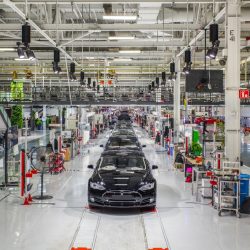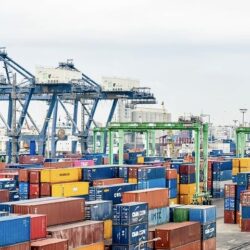
Tesla’s full-year results show that it has navigated the supply chain challenges and chip shortages that have frozen the rest of the auto industry. This is a far cry from the electric car company’s embarrassing display of Silicon Valley hubris and results a few years ago, as it ramped up the Model 3, when it had failed to appreciate either the complexities of car manufacturing or the business drivers of I4.0. Now, some of that Silicon Valley skill has become a competitive advantage, say RalfW.Seifert and Richard Markoff.
By RalfW. Seifert andRichard Markoff
Tesla has reported a record net profit of$2.32 billion in the fourth quarter of2021, showing that Elon Musk’s pioneering electric car company has weathered the supply chain congestion better than its competitors, providing a real-world demonstration of supply chain principles that have been long understood but have proven difficult to implement.
When Tesla set out to build its factory in California for the widely anticipated Model 3, the company set out to rethink car manufacturing.The CEO,Elon Musk, loudly claimed thatexisting car plants were“tortoises”;Tesla, he said,wouldbuild a nearly fully automated facilityon the cutting edge of the growing trend thatwascoming to be known as“Industry 4.0”.
To many supply chain veterans, this sounded a lot like Silicon Valley talk of disruptionthatthey had heard in other industries.Innovations are always welcome, but the excess of the rhetoric gave the impression thatMusk felt that there was a lack of competence in car manufacturing, and he was coming to solve the problem.
When Tesla was beset by along, publicseries of production delays, safety,andquality issues,it became clear that Musk had to change course.The companyhiredworkersandscaled back its technologyand automationambitions.By the time the Model 3 was supplying reliable volumes to a waiting market, thefactory very much resembledthose ofits peers.
For many supply chainmanagers, the story of the Model 3isa cautionary tale of automation. The selection and implementation of digital technologies should stem from clear business drivers,meshing with a business strategy, an understanding of the benefits, and a clear implementation plan. Tesla had tried to implement automation and technology for its own sake, rather than from an identified need or benefit. Industry 4.0 is not a principle to be obeyed, it is a tool in service of a strategy.
The semiconductor supply chain crunch
Thinking like a tech company can have benefits, however.Most are nowaware of thesupply shortage of semiconductorsthat has been impacting manufacturing across sectors and regions since the start of 2021.
Particularly hard hit has been the automotive sector.Like any product with digital capabilities, cars require several small semiconductor chips. These chips are not an expensive component in the car,there are only two to three dozen in each,but they are essential and without them production is halted, with stoppagesthatare continuing to impactevery major car manufacturer.
Tesla has managed toavoid the brunt of the crisisinsemiconductor supply, andhowthe manufacturer hasdone it should be of interest to every supply chain manager.
Just as Tesla insisted on controlling its battery supply chain when it built the Gigafactory in Nevada, the companybuilt in-house capability to write the software codethat runs its cars, whereas itscompetitors relied on suppliers for this expertise.Though it stretched the core competency scope and was more expensive,this decisiongave Tesla the ability to rewrite its software code to accommodate and work with whatever semiconductors the companywas able to procure.Tesla’scontrol and agility overitssoftware providedthe companywith inherent flexibility to change suppliers and semiconductors as needed.Its intimacy with its onboard computer design and software also pushed it to standardize chips, so each car has fewer chip SKUs to procure.
In addition to needing fewer chip SKUs and being flexible to accommodatesubstitutes, it’s worth pointing out that Tesla has few finished product SKUs.There areonly four modelsof Tesla vehicles (pictured above, Courtesy of Tesla, Inc.),compared toover 40 passenger vehicle models for Toyota, the world’s largest manufacturer.
A story with many morals
Through its learning curve in becoming a car manufacturer, Tesla has shown us how critical it is to approach supply chain digitalization within the framework of a business strategy and context, respecting and leveraging the knowledge of the firm rather than seeking to supplant it.
With those growing pains behind it, Tesla is now providing valuable lessons on the power of building in flexibility, seeking design standardization where possible, and the costs of complexity that large SKU portfolios can bring.
This article was first publishedby IMD on January 27, 2022.
Ralf Seifertis Professor of Operations Management at IMD. He directs IMD’s newDigital Supply Chain Managementprogram, which addresses both traditional supply chain strategy and implementation issues as well as digitalization trends and new technologies.
Richard Markoffis a supply chain researcher, consultant, coach and lecturer. He has worked in supply chain for L’Oréal for 22 years, in Canada, the US and France, spanning the entire value chain from manufacturing to customer collaboration.
Related posts:
Tesla gears up Gigafactory for launch of Model 3
Tesla’s mission to produce sufficient electric vehicles to force change in the automobile industry is accentuating its focus on lithium…
Read moreTesla chooses to build first European factory in Berlin
Berlin has been chosen as the location for Tesla’s first European production plant. The carmaker’s ‘gigafactory’ will be built close…
Read moreDigesting the shocks: how supply chains are adapting to the COVID-19 lockdowns
As the world grapples with the human and economic crisis unravelling before us, supply chains are finding themselves squarely within…
Read moreSupply chains aren’t broken, it’s more a question of demand
Mainstream news reports are full of claims that supply chains are broken, citing widespread product shortages, overflowing ports and spiking…
Read more



